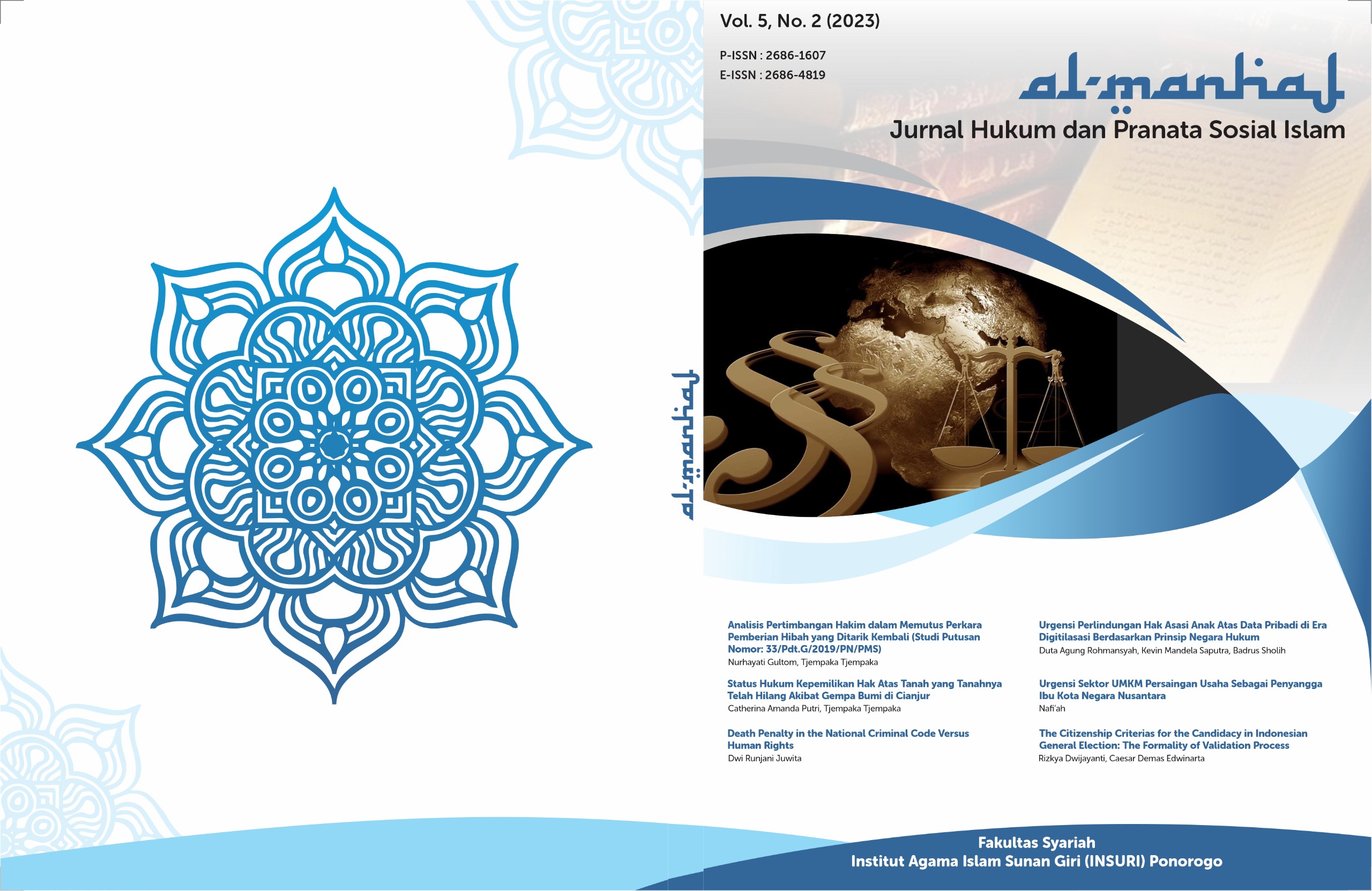Kedudukan Alat Bukti Elektronik dalam Pembuktian Tindak Pidana
DOI:
https://doi.org/10.37680/almanhaj.v5i2.2878Keywords:
Evidence; Verification; CrimeAbstract
The legal implications caused by social change, especially technological developments (electronic devices) lie in the need for evidence by presenting electronic evidence in court. In Indonesian criminal law, the use of electronic evidence has actually been regulated. This study aims to determine and analyze the status of electronic evidence, especially in criminal trials after the enactment of the ITE Law and to find out the role of electronic evidence in Indonesian criminal law. Then it is reviewed and analyzed the characteristics and analysis of the electronic evidence so that it can be used as a reference for the judge's opinion in court. This search is a library search or literature search. The material is taken from various literature related to research. This journal writing method uses normative legal methods using statutory approaches and conceptual approaches. The results of the study show that the Criminal Procedure Code is still general in nature and does not recognize evidence in electronic form that can be used as a source of interest as evidence in court cases, electronic evidence itself is a form of expansion/development of evidence guidance so that in the Criminal Procedure Code the status is electronic evidence evidence.. Based on a survey on the status of electronic evidence in Indonesian criminal law, the status of electronic evidence according to ITE (Electronic Information and Transaction Law) is considered valid as long as the authenticity of the evidence can be proven and recognized by professionals. and submitted in accordance with applicable regulations.
Downloads
References
Alwi, Hasan. (2002). Kamus Besar Bahasa Indonesia Edisi Ketiga. Jakarta: Balai Pustaka. Anatta Sannai. (2008). Pengertian Teknologi Informasi dan Komunikasi (online).
Arni Muhammad. (2005). Komunikasi Organisasi. Jakarta: Bumi Aksara.
Azhar Susanto. (2002). Sistem Informasi Manajemen Edisi Dua. Bandung: Lingga Jaya. Badudu J.S. (2003). Kamus Kata-kata Serapan Asing dalam bahasa Indonesia. Jakarta: Kompas. Bugishq. (2010). Hakikat Teknologi Informasi dan Hakikat Teknologi Informasi.
D. Simons, 1952, Beknopte Handleiling tot het Wetboek van Strafvordering, Haarlem: De Erve n F. Bohn, Evi hartanti, tindak Pidana Korupsi edisi kedua, Sinar Grafika, Jakarta, 2009
Johny Ibrahim, Teori dan Metodologi Penelitian Hukum Normatif, UMM Press, Malang, 2007
Josua Sitompul, Cyberspace, Cybercrimes, Cyberlaw : Tinjauan Aspek Hukum Pidana, Tatanusa, Jakarta, 2012
Lilik Mulyadi, Tindak Pidana Korupsi di Indonesia; Normatif, Teoritis, Praktik, dan masalahnya, (Bandung: alumni, 2007)
M. yahya Harahap, Pembahasan Permasalahan dan Penerapan KUHAP: Pemeriksaan Sidang Pengadilan, Banding, Kasasi, dan Peninjauan Kembali, Edisi Kedua, (Jakarta: Sinar Grafika, 2009)
Munir Fuadi. 2012. Teori Hukum Pembuktian (Pidana dan Perdata).Bandung: Citra Aditya Bakti
Muhammad Nuh Al-Azhar, Digital Forensic: Panduan Praktis Investigasi Komputer (Jakarta: Salemba Undang-undang
Undang-Undang RI Nomor 8 Tahun 1981 tentang Hukum Acara Pidana.
Undang-Undang RI Nomor 31 Tahun 1999 tentang Pemberantasan TindakPidana Korupsi.
Undang-Undang RI Nomor 20 Tahun 2001 tentang Perubahan Atas Undang-Undang RI Nomor 31 Tahun 1999 tentang Pemberantasan Tindak Pidana Korupsi.
Undang-Undang RI Nomor 21 Tahun 2007 tentang Pemberantasan Tindak Pidana Perdagangan Orang. Undang-Undang RI Nomor 11 Tahun 2008 tentang Informasi dan Transaksi Elektronik.
Undang-Undang RI Nomor 19 Tahun 2016 tentang Perubahan Atas Undang-Undang RI Nomor 11 Tahun 2008 tentang Informasi dan Transaksi Elektronik.
Downloads
Published
How to Cite
Issue
Section
License
Copyright:
- Author retains the copyright and grants the journal the right of first publication of the work simultaneously licensed under a Creative Commons Attribution 4.0 International License that allows others to share the work with an acknowledgment of the work's authorship and initial publication in this journal.
- Author is able to enter into separate, additional contractual arrangements for the non-exclusive distribution of the journal's published version of the work (e.g., post it to an institutional repository or publish it in a book) with the acknowledgment of its initial publication in this journal.
- Author is permitted and encouraged to post his/her work online (e.g., in institutional repositories or on their website) prior to and during the submission process, as it can lead to productive exchanges, as well as earlier and greater citation of the published work (See The Effect of Open Access).
License:
-
Attribution — You must give appropriate credit, provide a link to the license, and indicate if changes were made. You may do so in any reasonable manner, but not in any way that suggests the licensor endorses you or your use.
-
No additional restrictions — You may not apply legal terms or technological measures that legally restrict others from doing anything the license permits.
You are free to:
- Share — copy and redistribute the material in any medium or format
- Adapt — remix, transform, and build upon the material for any purpose, even commercially.

This work is licensed under a Creative Commons Attribution 4.0 International License.














